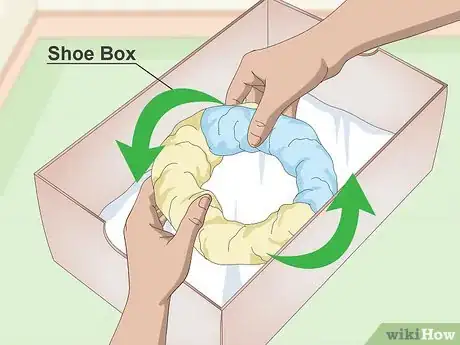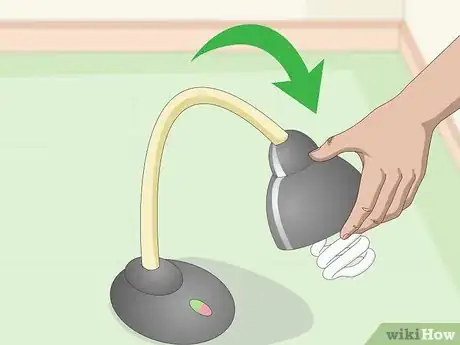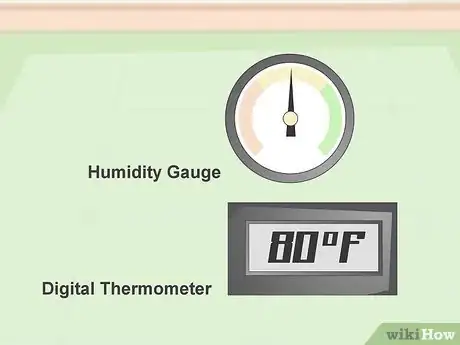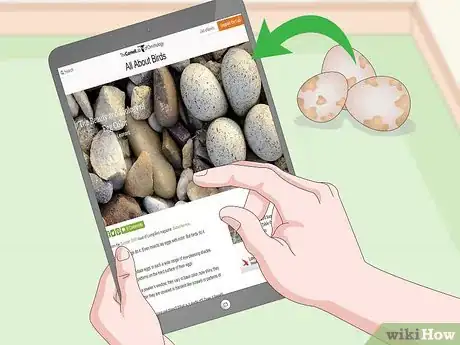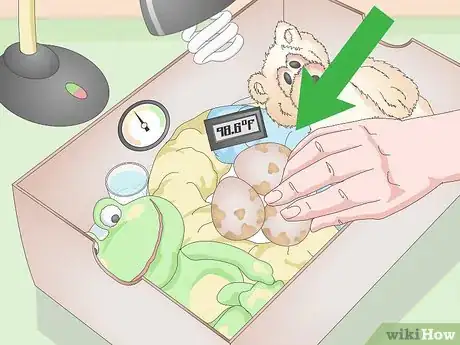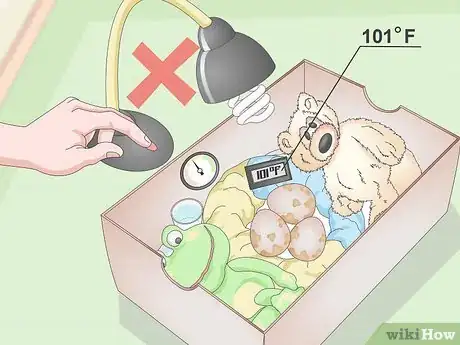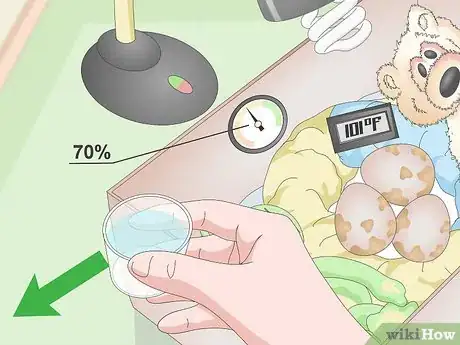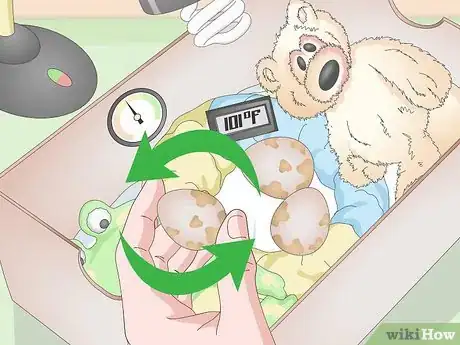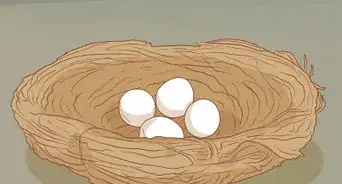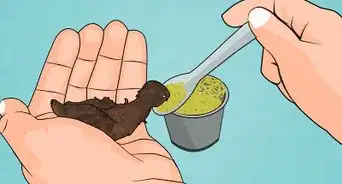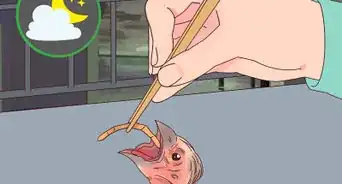This article was co-authored by wikiHow Staff. Our trained team of editors and researchers validate articles for accuracy and comprehensiveness. wikiHow's Content Management Team carefully monitors the work from our editorial staff to ensure that each article is backed by trusted research and meets our high quality standards.
There are 8 references cited in this article, which can be found at the bottom of the page.
wikiHow marks an article as reader-approved once it receives enough positive feedback. In this case, 89% of readers who voted found the article helpful, earning it our reader-approved status.
This article has been viewed 211,448 times.
Learn more...
If you want to hatch some wild bird eggs that you've found but don't have the money for a professional incubator, you can easily create one from household items. Once you've assembled the incubator, you'll be ready to prep the eggs for hatching. Be careful, though! The Migratory Bird Treaty Act makes it illegal to disturb most nests without a permit from your national government. This law affects North America, the United Kingdom, Japan, and Russia.
Steps
Assembling the Incubator
-
1Line a medium sized shoebox with cloths. Lay a small, soft cloth on the bottom of the box. Roll up two rags like a burrito and lay them together in the box to form a circle or a ring in the middle. The width of the ring will depend on how many eggs you have and how large they are.[1]
-
2Insulate the nest with feathers. Buy a bag of feathers from your local craft store. Use the feathers to line the cloth ring in the middle of the box. Feathers store heat well, and will help the eggs stay warm.Advertisement
-
3Add two to four small stuffed animals. The number depends on how large the stuffed animals are and how much room you have in the box. Arrange them around the circumference of the circle to enclose the egg more for warmth. Make sure the stuffed animals are big enough to press against the sides of the shoebox and push the rags and feathers closer to the eggs.
-
4Fill a small cup of water for humidity. Place it in the corner of the box to prevent spills. Refill the water daily or as the water level goes down with evaporation. Check the water at least twice a day.[2]
-
5Find a small heat lamp. Look for an inexpensive one at charity shops or garage sales. For a high-quality lamp, shop at your local pet supply store. Buy a lamp with an adjustable neck that you can reposition to achieve the ideal temperature.[3]
- Make sure the heat lamp does not touch any of the flammable materials in the nest box, as this could cause a fire.
-
6Buy a digital thermometer and a humidity gauge. Digital readouts make it easier to track temperatures to the tenth of a degree. You'll need this kind of precision when incubating eggs. Look for these instruments in any big box store. Many locations sell single devices that measure both temperature and humidity.[4]
-
7Heat the box. Position the lamp so that the light is shining into the box. Place the thermometer and humidity gauge in the location you'll place the eggs. Aim for a temperature of about 98.6 °F (37.0 °C) and a humidity level between 55 and 70 percent.[5]
Incubating the Eggs
-
1Determine the species of your eggs. This will help you to recreate the ideal temperature and humidity level. Take the eggs to your local extension office for identification. You can also visit several online resources, such as:
-
2Place the eggs in the incubator. Lay them in the washcloth ring you set up. Place them side by side. Don't lay them on top of each other. Otherwise, you could break them during rotation.
-
3Put the box in indirect sunlight. Sunlight provides more warmth without lowering the humidity. Keep the box out of direct sunlight, which could raise the temperature to dangerous levels. You could put the box in a west-facing window in the morning or an east-facing window in the afternoon. If the weather is warm enough, put the box outside in a semi-shaded spot out of the reach of predators during the day.
- Depending on the species of the bird, longer periods of daylight might make your eggs hatch a bit sooner.[8]
-
4Monitor the temperature. Turn off the heat lamp if the temperature goes above 101 °F (38 °C). Keep it off until the temperature drops to the ideal level. If you notice the heat getting too high on a regular basis, try repositioning the lamp.[9]
-
5Watch the humidity level. The exact level depends on the species you're incubating.[10] Add more water to raise the humidity. If you keep getting readings above 70 percent, reduce the amount of water you have in the incubator.
-
6Rotate the eggs a several times a day. Don't spin them, just turn them. You could buy a mechanical egg rotator at your local farm supply store. However, if you're around the incubator regularly, you can rotate the eggs by hand. How often you need to rotate them depends on the species, but the average rate is about two rotations per hour.[11]
-
7Replace the box lid when you switch off the lamp. Most species can handle cool temperatures as low as 61 °F (16 °C), so it shouldn't hurt the eggs if you switch off the lamp when you go to sleep.[12] Replacing the lid will help to lock in some heat overnight. Just remember to remove the lid and turn the heat lamp back on in the morning. Set a reminder for yourself to be on the safe side.
-
8Be prepared for the possibility that the eggs will not hatch. Unfortunately, the chances of successfully hatching wild bird eggs an incubator are low. Natural incubation by the parent birds is a complex process that is very difficult to recreate.[13] Eggs that are cracked or that have been outside the nest for any length of time are unlikely to be viable.
Community Q&A
-
QuestionHow can I know if there is anything in the egg?
 Community AnswerIf you candle it -- put a flashlight up to the egg in a dark room to see what is happening inside it -- you should be able to see something in it. It is easier to tell if the egg is older because you can tell if the baby inside is moving or not.
Community AnswerIf you candle it -- put a flashlight up to the egg in a dark room to see what is happening inside it -- you should be able to see something in it. It is easier to tell if the egg is older because you can tell if the baby inside is moving or not. -
QuestionIf the wild egg is cold, will it still have a chance to survive?
 Community AnswerIt depends on how long the egg has been cold for. The longer it has been cold for, the less likely it will be to survive. If it has been cold for only a very short period of time, however, it may survive.
Community AnswerIt depends on how long the egg has been cold for. The longer it has been cold for, the less likely it will be to survive. If it has been cold for only a very short period of time, however, it may survive. -
QuestionIs there anything I can substitute for a heating lamp?
 Community AnswerA heating lamp is ideal, as nothing else can replicate the temperature it provides. If you don't have one, you could try a regular lamp, or a heated blanket to keep it warm.
Community AnswerA heating lamp is ideal, as nothing else can replicate the temperature it provides. If you don't have one, you could try a regular lamp, or a heated blanket to keep it warm.
Warnings
- Remember that the birds' lives are on the line. Don't just throw an incubator together. Make it efficient.⧼thumbs_response⧽
- Always wash your hands after handling the eggs.⧼thumbs_response⧽
- If you live in a country that was part of the Soviet Union between 1917 and 1991, you might still be subject to the Migratory Bird Treaty Act. Check your national statues for clarification.⧼thumbs_response⧽
Things You'll Need
- Shoebox
- Washcloths
- A small, soft cloth
- Heat lamp
- Digital thermometer
- Digital humidity gauge
- Small cup or dish with water
- Small stuffed animals
References
- ↑ https://www.youtube.com/watch?v=fryW9V-5IPI
- ↑ https://www.youtube.com/watch?v=WQ1tyfvenqQ
- ↑ https://www.youtube.com/watch?v=WQ1tyfvenqQ
- ↑ https://www.youtube.com/watch?v=WQ1tyfvenqQ
- ↑ https://www.bto.org/volunteer-surveys/gbw/gardens-wildlife/garden-birds/behaviour/incubation
- ↑ http://www.audubon.org/bird-guide
- ↑ http://www.sialis.org/nests.htm
- ↑ https://www.allaboutbirds.org/study-how-the-amount-of-daylight-affects-incubation-length/
- ↑ https://www.youtube.com/watch?v=WQ1tyfvenqQ
About This Article
To create an egg incubator for wild bird eggs, line the bottom of a shoe box with a soft cloth and roll up 2 other cloths to form a circle in the middle. Next, add real bird feathers around the circle, which you can buy from any craft store, and 2-4 stuffed animals for additional warmth. Then, place a small cup of water in the corner of the box to create humidity. Finally, buy a small heat lamp, a digital thermometer, and a humidity gauge to help you regulate the environment. For tips on monitoring the eggs in your incubator, read on!
